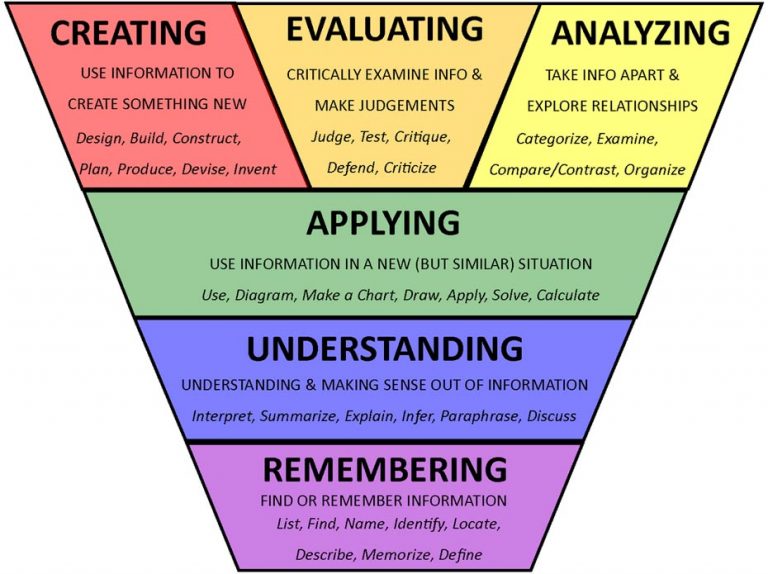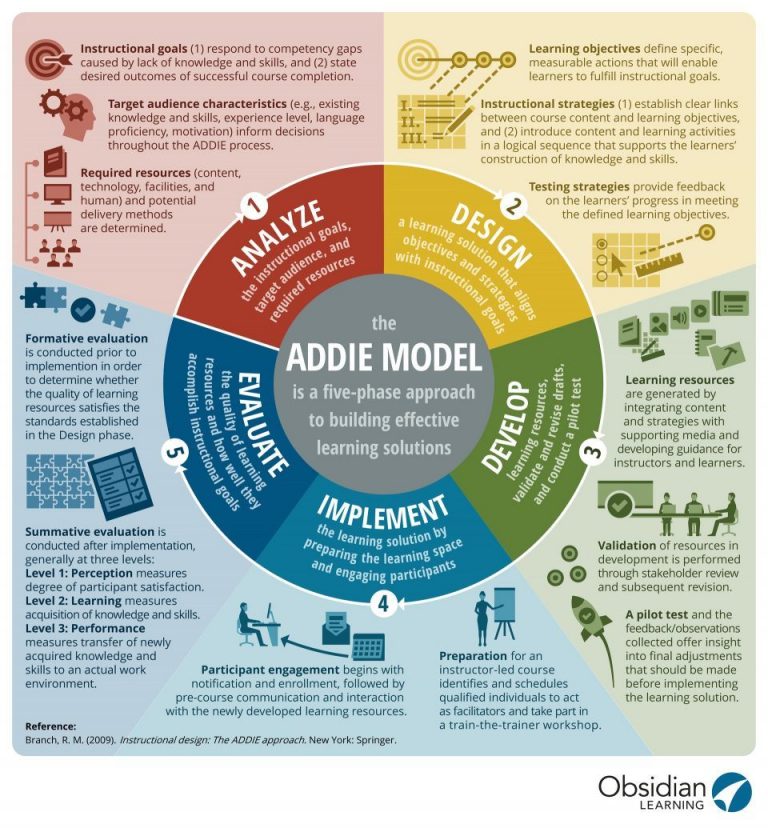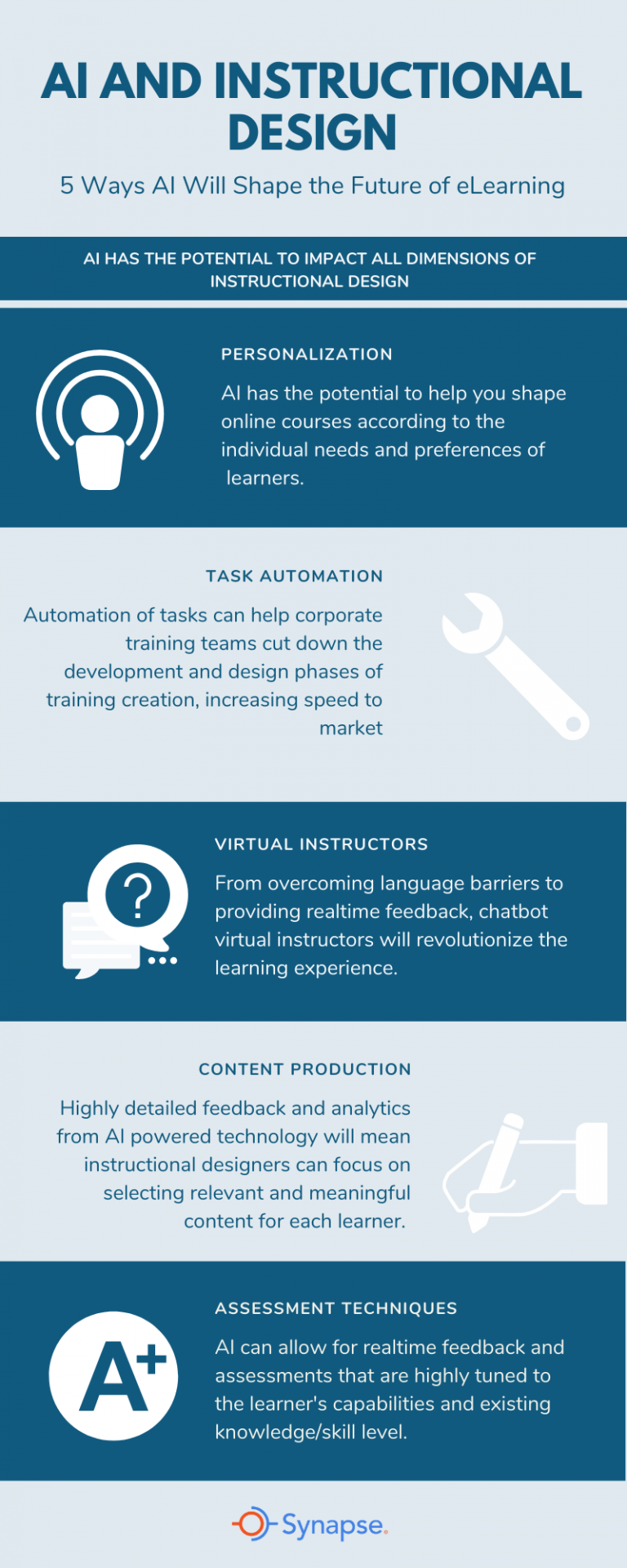
Instructional design is the design, development, and delivery of learning experiences. It constructs those experiences in such a way that learners acquire either knowledge or skills . Instructional designers follow various academic theories and models related to how people learn and the cognitive processes behind the learning experience. These models ensure the instruction is as effective as possible for imparting knowledge or teaching skills to learners.
A learning experience can refer to anything from teachers in the classroom, to online courses, instructional manuals, PowerPoint presentations, and simulations. It includes any experience where the intention is for learning of any kind to take place.
Instructional designers are considered the “architects” of learning experiences . In both the education and corporate environment, they often serve as directors and project managers of the course/lesson development process.

The emergence of instructional design as an academic subject and profession came about through a combination of other disciplines including behavioural sciences, military training practices, and education.
The basis of instructional design theories as we know them today is rooted in World War II. Soldiers needed extensive training on many complex tasks. Using research from B.F. Skinner’s studies in behavioural science, military instructors learned to break tasks down into individual learning goals. In doing this, they saw much better results.
From there, many of the successful military training practices from the war were transferred to business and education. Throughout the rest of the twentieth century, theories, models, and processes around learning sprang up and were fine tuned. A lot of these theories still inform the way we learn in school and are trained at work today.
When it comes to designing a learning experience, instructional designers must take three main components into account to ensure the learning is effective: learning objectives, learning activities, and assessments. This is known as the “Magic Triangle” of learning .
For example, there must be a learning objective which explicitly states what a learner should be able to do once they have completed the course/lesson. This learning objective will then inform the types of activities chosen to be included on the course. The types of assessments and their difficulty level will also be informed by the learning objective and learning activities.
Once these three elements are aligned, effective learning can take place
A learning objective defines and sets boundaries on what learners should know or be able to do at the end of the course that they couldn’t do before.
They are a way to clearly define the expected outcome of a course in terms of demonstrable skills or knowledge that will be acquired by the learner as a result of the instruction provided. The most important part of a learning objective is that its success can be measured.
Many instructional design models and theories provide explicit verbs and best practices for constructing learning objectives and using them correctly. They are seen as critical to the learning process because they inform all other instructional design decisions thereafter.
Check out these articles for further reading on learning objectives:
What is a learning objective?
How to write a learning objective
Learning Activities are all the course assets used to deploy the learning experience. They are actions that are planned and created by instructional designers during course design and taken or used by the learner during the learning process.
Types of learning activities can range from audio, video, animation, gamification, and simulation, to more traditional activities such as reading and lecturing.
Check out this free ebook to learn more about what you can do during the training development process to ensure your course provide effective learning for employees.
Assessments are the final step in the learning process. Learning assessments include elements like quizzes, exams, or graded simulations of real-world situations.
They are the final point in the “Magic Triangle” of instructional design because they are a way of checking that the learning objective was met. Moreover, they’re an important part of the cognitive “action and reflection” processes needed for learning to take place effectively.
Summative assessment usually quantifies results on a graded basis (e.g. 8/10 is considered a “pass”). This method is often criticized for being too simplistic and arbitrary to truly evaluate the learners’ achievement or the effectiveness of the training material. However, these downsides can be mitigated with effective pre-testing and post-testing .
Formative assessment seeks to measure the learning journey as opposed to hard and fast results at the end of a course. It can be more qualitative and provide unique insights and a “bigger picture” mentality to assessing an individual’s learning journey.
Want to learn more about using assessments effectively in instructional design?
Check out this on-demand webinar recording:
5 Ways Effective Assessments Can Catapult Your Learning Outcomes
While the three components of learning discussed above are universally accepted as being vital to the learning process, how that learning should be designed by instructional designers has been hotly debated over the last few decades. Several popular models have come and gone over the years, but there are some that continue to endure today, as well as more recent, enlightened takes on how instructional designers should approach course design.
Bloom’s Taxonomy is a hierarchical model for classifying different levels of complexity in the learning process. The model categorizes learning objectives into three core principles: Cognitive, Affective, and Psychomotor.
The Cognitive model is the most widely used when it comes to creating learning objectives during instructional design. The idea is to view learning objectives in behavioural terms so that they can be easily defined and measured according to what knowledge/skills the learner acquires and how their behaviour (or performance) improves as a result.
The model is framed to show how learners can move up structured levels of complexity in their depth of knowledge and level of skill in a given topic or process.
Bloom’s Taxonomy is useful for instructional designers because they can use it to:

Source: Carleton University
ADDIE is another instructional design framework used by instructional designers to develop training courses.
The model involves five main phases for course development:
ADDIE was originally created for the armed forces back in the 1970s, but it was quickly adopted by instructional designers across the whole spectrum of learning experiences and is still a highly popular tool to this day.
The different activities that take place in each phase of ADDIE vary according to the situation and learning environment. But the five main phases mentioned above are almost always present when ADDIE is used by instructional designers.

Analysis
Perform a needs analysis by surveying the existing learning environment and identifying the existing knowledge levels and skills. This stage clarifies instructional problems and objectives.
Design
Select learning objectives, assessment instruments, exercises, content, subject matter analysis, lesson/module planning, media selection, and delivery methods.
Development
Create and assemble content assets according to the Design phase. Develop storyboards and technologies. Perform quality assurance testing and iterate on design elements that need more work.
Implementation
Deploy courses to learners through the appropriate vehicle (instructor-led training, eLearning, etc.). Develop procedures for training facilitators and learners.
Evaluation
Evaluating the effectiveness of the course design. Originally listed as a separate, final phase of the model, but today is widely practiced as a continuous stage alongside the other four phases, to take a more iterative approach to instructional design.
Check out this on-demand webinar recording by eLearning Brothers and Synapse
outlining five essential ingredients for effective course design.
SAM is the Successive Approximation Model, a framework for instructional design that was developed in answer to the more agile approach to product and business development being adopted by organizations en masse.
SAM is widely used by L&D teams who need to take a fast, iterative approach to course development so they can keep up with the demand for training in their organizations. It is a much more fluid process than traditional instructional design methods, allowing (even encouraging) teams to collaboratively fail fast and repeatedly. The idea is that the more you try and fail, the quicker you will get to the perfect solution.
Design Thinking is a philosophy and process that focuses on the user, challenges assumptions, and redefines problems in an attempt to identify alternative strategies and solutions that might not be instantly apparent with an initial level of understanding.
It is a way of thinking and working, but also comprises a collection of hands-on methods. The five steps or phases of Design Thinking are:
Just like SAM, this methodology was not originally developed for instructional design. Design Thinking developed over time across a number of different fields, all trying to address the same problem: how can we creatively problem-solve while addressing the needs of the end user? It’s earliest origins can be traced back to the ‘50s and ‘60s and it was first used in fields like engineering and architecture.
In more recent years, it has made its way into the interests of instructional designers as they attempt to design training around complex, multi-faceted problems in the organization.
How Design Thinking is Transforming the Learning Experience
Learn all about the concept of Design Thinking and
how to leverage it in your corporate training design process.
Technology and the internet have changed the face of instructional design and the way employees learn in the workplace. Although instructional design and corporate learning were arguably quite late to the party when it came to the transition to digital, online learning is now in full swing and grows more sophisticated by the year.
eLearning is the delivery of learning or training through any digital method. It has largely replaced traditional instructor-led training (ILT) in many workplaces and continues to do so. It is generally more cost-effective and when designed correctly, can be far more effective than marathon (ILT) sessions.

As instructional designers seek to meet the continually evolving demands of the modern learner, several instructional design trends have emerged as answers to roadblocks commonly experienced in corporate training development.
Microlearning is any learning experience in which the content takes between 2-10 minutes for the learner to consume.
Its popularity stems from the fact that learners are more pressed for time and distracted than they have ever been before. By providing learning in bite-size microlearning courses, employees can fit training around their jobs rather than the other way around.
It also allows employees to learn in the flow of work, so they can learn what they need, at the point of need.
Download this free ebook for a microlearning strategy
you can start implementing today.
Learn how Solenis used rapid instructional design and enhanced collaboration
with SMEs to revolutionize the generation and distribution of their training.
Following the trend of meeting learners where they are, mobile learning allows users to access courses from the endpoint of their choosing. It’s another example of how instructional design has adapted to fit the needs of the modern lifestyle and work schedule.
With mobile learning, users can access courses from home, in transit, or outside of regular working hours. Savvy instructional designers can also ensure the way they deploy these courses is more “native” to the mobile experience and similar in design to other apps that employees use every day.
A major challenge for instructional designers with such an impatient and distracted workforce is learner engagement. Most people are used to doing some kind of mandatory compliance training in one form or another. But learning and development teams often struggle to ensure employees are taking advantage of other learning opportunities available to them.
Gamification is when game-design is applied to traditionally “non-game” activities, such as learning. The theory can be applied to learning activities such as incorporating rounds, stages or levels, simulations, the collection of items of value, the gaining of points, winning or losing, or a race against the clock.
The term “blended learning” comes from the practice of combining traditional instructor-led training in a classroom setting with online learning and independent study. This style of learning is common to both the education and corporate sectors, but the term “ blended learning ” is often found in the corporate learning environment.
It’s widely agreed that blended learning is made up of three core components:
The blended approach can often start with a more substantial focus on in-person training, and be followed up by more independent learning afterward once the core concepts have taken root.
From planning to design to deployment, a lot is involved for instructional designers to create a course and deliver it to learners. With each step in the process, different instructional design software and tools are needed.
The front end of instructional design requires a lot of planning and collaboration. Like most business functions, this was traditionally done by learning and development teams over email, spreadsheets and word documents. The Learning Design System was developed to address the bottlenecks created during the planning and development phase of instructional design.
The software helps to standardize and automate processes around:
Corporate training teams rarely stand in an individual silo in today’s agile business world. Extensive collaboration is often needed with external vendors and internal stakeholders. As the demand for training increases, it’s imperative for L&D to have a centralized view of all their ongoing projects and activities.
Project management software keeps instructional designers on track and aligned with each other and with objectives. Many project management tools available also integrate seamlessly with other popular software, making the transition as seamless as possible.
Authoring tools are software that has pre-programmed elements designed for developing interactive multimedia and creating digital content. Many authoring tools have been developed specifically for elearning content creation so instructional designers can build interactive elearning courses.
Authoring tools for elearning have also been built to enable specific outputs that are needed to deploy courses to other software such as Learning Management Systems. Output types for elearning authoring tools include SCORM and HTML5.
Popular authoring tools for instructional designers include Adobe Captivate, Articulate Storyline 360, Elucidat, and Camtasia Studio 8.
In recent years, many L&D teams are shifting focus away from content creation, and towards content curation . This involves instructional designers selectively choosing a stock of resources, both internal and external, to present to learners rather than focusing on brand new content every time a learning opportunity is presented.

A Learning Management System (LMS) is a software system or platform where elearning courses can be deployed, tracked, reported on, and delivered to learners. LMS’s vary wildly in the types of features and functionality they deliver, but the core of it all is to deliver completed elearning courses to the end user: the learner.
It’s been predicted in recent years that the LMS may become obsolete in the near future as instructional design software and technology continues to evolve. But experts are divided on this, and it certainly seems that the LMS won’t be disappearing any time soon.
The LMS is one of the most important purchases the learning and development team makes because it’s how the learners themselves will interact with your online course. The functionalities of your LMS can dictate a lot about how you design learning content. Of all learning technologies, the LMS provides the most scope and choice. Popular vendors include TalentLMS, Docebo, Adobe Captivate Prime, Litmos, Lessonly, and Workday.
Most learning technology adheres to one of two main standards so that content can easily be deployed from design and development tools to the LMS. These standards are known as SCORM and xAPI.
SCORM stands for Shareable Content Object Reference Model. It’s a collection of specifications and standardized approaches to how web-based elearning products are built and formatted.
SCORM is currently the most widely adopted elearning standard in the industry. The protocol allows elearning content and programs to work together. For example, an elearning course might be built in an authoring tool and be seamlessly passed on to a Learning Management System for delivery to learners because they both compatible with SCORM.
xAPI is short for Experience API. It’s also known as Tin Can API. It was created as a successor to SCORM, which has certain limitations. xAPI makes it possible to collect a lot more data about a much wider range of learning experiences, both online and offline.
The xAPI protocol means that data and records about learners can be easily stored, retrieved, and shared across various platforms. Records collected and stored are referred to as activity statements which are then aggregated and stored in a Learning Record Store (LRS).
The advantage of xAPI over SCORM is being able to capture information about a wide range of activities and capturing offline learning moments, too. It gives L&D a much more comprehensive set of data and information to work with when analyzing their learning programmes.
Watch the recording of Thomas Bernard, Global Learning Leader at Solenis, and Kristy Sadler,
CMO at Synapse, to learn how Solenis built an innovative, award-winning learning strategy.
One of the key trends in learning and development right now is the push to personalize learning experiences for the individual user as much as possible.
A Learning Experience Platform (LEP) is software that is designed to provide personalized learning content and learning pathways for employees by consolidating lots of different learning resources. It’s usually used by large enterprises and leverages social learning and networking as well as personalization to provide a total learning experience.
Unlike a traditional LMS, the LEP puts control back into the hands of the learner as they can choose what they would like to engage with on the platform. Popular vendors of Learning Experience Platforms include Degreed, Pathgather, Edcast, and Cornerstone.
While many would argue that instructional design and learning and development have been a little late to the party, there’s no arguing with the fact that technology is finally starting to make serious advancements in how we design and deliver learning experiences.
While many would argue that instructional design and learning and development have been a little late to the party, there’s no arguing with the fact that technology is finally starting to make serious advancements in how we design and deliver learning experiences.

Learners are becoming ever more impatient in today’s digital world. People are overwhelmed by the sheer volume of information they must process on a daily basis. This tidal wave of information has made them far more selective about what they choose to process, and it affects their attention span for learning experiences, too. Learners today want highly relevant, bite-sized learning experiences that help them with their day-to-day performance.
That’s where Artificial Intelligence in elearning comes into play. AI has the potential (and has already started) to shape highly personalized learning experiences through recommendation engines, similar to Netflix or ecommerce product recommendations. In a learning environment, AI can suggest resources or experiences that are specific to the learner’s role, experience level, and performance issues. It can monitor their profession and automate the process of moving an employee through the hierarchy of learning.
This level of personalization means learners are presented with the right training at the right time for them. It reduces frustration at being put through courses that are not relevant or material that is too easy or too difficult. Ultimately, the end result will be learners that are more engaged and training that is more effective.
AI has the potential to change the way instructional designers develop, design, and deploy learning experiences.
Currently, many processes undertaken by instructional designers are still highly time-consuming and manual despite the vast array of learning technology already available. Artificial Intelligence has the potential to automate aspects of tasks like training needs analysis, course content development, and other instructional design processes. Much like the recommendation engines that are personalizing the learning experience, AI can automate a lot of the processes around learning objectives, content selection and assessments based on adult learning theory.
Adaptive learning is the use of technology to create personalized learning experiences online through Learning Experience Platforms or Learning Management Systems. Adaptive learning is becoming an increasingly popular trend in corporate training as the tools and technology to achieve it become available. In fact, a report by Docebo found that 33% of learning leaders plan to focus on adaptive learning in 2020.
Adaptive learning is comprised of three core functionalities:
It has been decades since the benefits of “one on one” teaching and the benefits of paying individual attention to learners were realized. Adaptive learning aims to transmit that one-to-one teaching concept to an elearning environment. The “instructor” (algorithms) present a similarly personalized and optimized learning experience to that of a tutor and an individual student. This is mostly achieved through the constant collection of data and feedback so that the technology can adapt based on learner responses to tasks and assessments.